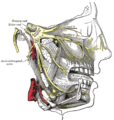|
Zygomatic nerve
The zygomatic nerve is a branch of the maxillary nerve (itself a branch of the trigeminal nerve (CN V)). It arises in the pterygopalatine fossa and enters the orbit through the inferior orbital fissure before dividing into its two terminal branches: the zygomaticotemporal nerve and zygomaticofacial nerve. Through its branches, the zygomatic nerve provides sensory invervation to skin over the zygomatic bone and the temporal bone. It also carries post-ganglionic parasympathetic axons to the lacrimal gland. It may be blocked by anaesthetising the maxillary nerve. StructureOriginThe zygomatic nerve is a branch of the maxillary nerve (CN V2).[1][2] It arises at the pterygopalatine ganglion.[1] CourseIt exits from the pterygopalatine fossa through the inferior orbital fissure to enter the orbit.[1][3] In the orbit, it travels anteriorly along its lateral wall.[3] BranchesSoon after the zygomatic nerve enters the orbit, it divides into its branches. These include:
VariationSometimes, the zygomatic nerve does not branch within the orbit. Instead, it enters a single foramen in the zygomatic bone called the zygomatico-orbital foramen. In this case, it divides within the bone into the zygomaticotemporal nerve and the zygomaticofacial nerve.[4] FunctionThe terminal branches of the zygomatic nerve contain sensory axons.[1] These provide sensation to the skin over the temporal bone and the zygomatic bone.[4] The zygomatic nerve also carries postganglionic parasympathetic axons.[1] These axons have their cell bodies in the pterygopalatine ganglion. They travel from the ganglion to the zygomatic nerve, and then to the lacrimal nerve through a communicating branch. From the lacrimal nerve, they enter the lacrimal gland and provide secretomotor supply.[5] Clinical significanceThe zygomatic nerve can be blocked indirectly by anaesthetising the maxillary nerve (CN V2).[2] The zygomatic nerve and its branches may be damaged by a fracture to the zygomatic bone.[6] Additional images
References
|
||||||||||||||||||||||||


